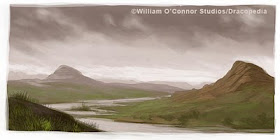
British Spitfire Dragonette(Dragonel)
Volucrisus britainicus
 Size: 25'
Size: 25'Wingspan: 30'
Recognition: Bipedal body with small fore limbs. Long tail and broad wings. Bright green and tan markings (male) Brown Markings (female)
Habitat: Highlands of the British Islands
Taxonomy: Draco/Aerodraciforme/Volucrisidae
/Volucrisus/V. britainicus
Soaring high over the lake district, or winging across the English Channel in bright formations, no sight in the dragon world conjures a more romantic image than the English Spitfire Dragonette. The Dragonette has a long history in Britain, beginning with its introduction by the Romans during the reign of Claudius in the 1st C. Although small breeds of wild dragonettes existed earlier, it is the Roman Dragonette that begins the proud tradition of riding dragons in England. When Rome abandoned its English provinces in the early 5th C. the English dragon riding tradition went fallow for hundreds of years during the reigns of the many saxon and viking warlords.
 In 1066 William the Conqueror reintroduced the riding dragon to England where today's breeds begin their lineage. During the middle ages the monarchy prided itself on a formidable dragon force, and many knights used riding dragonettes as their mounts. During the crusades many knights returned to England with Arabian breeds that were additionally added to English breeding stock. King Henry V is known to have rode an early English dragonette into battle at Agincourt. Even Oliver Cromwell is documented as having used the riding dragon during his campaigns.
In 1066 William the Conqueror reintroduced the riding dragon to England where today's breeds begin their lineage. During the middle ages the monarchy prided itself on a formidable dragon force, and many knights used riding dragonettes as their mounts. During the crusades many knights returned to England with Arabian breeds that were additionally added to English breeding stock. King Henry V is known to have rode an early English dragonette into battle at Agincourt. Even Oliver Cromwell is documented as having used the riding dragon during his campaigns.The modern riding dragonette that is today known as the British Spitfire was first documented in 1815 as the name of the mount of the Duke of Wellington at the Battle of Waterloo. The field marshal's fame led to the breeding of his personal dragonette into an seperate breed that became known as the Spitfire. The Spitfire became the most famous and popular riding dragonette breed during the nineteenth century, and in 1833 was adopted as the official breed of British Royal Dragon Guard, which was a small elite troop of British dragoniers, and is still to this day.
 The Spitfire is most famous for coming into its own during WWI. At the height of the war in 1914 there were over 1000 Spitfires on active duty, performing reconnaissance missions over enemy held territory. Sadly however the slow flying, unarmored dragons were easy prey to the new weapons and by the end of the war only a few dozen still remained having been completely eclipsed by airplanes. In WWII it is no coincidence that the most beloved and famous fighter aircraft was dubbed The Spitfire.
The Spitfire is most famous for coming into its own during WWI. At the height of the war in 1914 there were over 1000 Spitfires on active duty, performing reconnaissance missions over enemy held territory. Sadly however the slow flying, unarmored dragons were easy prey to the new weapons and by the end of the war only a few dozen still remained having been completely eclipsed by airplanes. In WWII it is no coincidence that the most beloved and famous fighter aircraft was dubbed The Spitfire.Today the Royal Dragon Guard still uses Spitfires as their mounts, and are kept at the Royal Mews, near Hyde park in London. These Spitfires are used for ceremonial purposes only, but the Spitfire is still a favorite among breeders and racers.

Spitfire Overhead View

Wild Spitfire Habitat
 To view a selection from the book or purchase Dracopedia visit:
To view a selection from the book or purchase Dracopedia visit:Amazon.com/Dracopedia
©2010William O'Connor/William O'Connor Studios/Dracopedia:A Guide to Drawing the Dragons of the World/The Dracopedia Project. All rights reserved.
